Sharing Lessons of Tsunami across the Pacific
Maki Sato, Tsunami storyteller
Kazuma Goto, Tsunami storyteller
Takuro Kimura, Director of GENSAI, the GLOCAL EMPOWERMENT, SUPPORT and AID INSTITUTE
In order to share what we have learned from the Great East Japan Earthquake, with other countries and put them to use in the future, the Japan Foundation and the Kahoku Shimpo Publishing Company co-organized a travelling workshop called Musubi Juku (linking workshop) in Chile in December 2013. Two survivors of the Japanese earthquake, both hailing from Miyagi Prefecture, visited Chile, a country which had experienced a devastating earthquake and tsunami in February 2010. The program participants gave accounts of the Japanese disaster and shared memories with victims of the Chile disaster. In this article, Maki Sato and Kazuma Goto, the two storytellers, reflect on their visit to Chile, and the program moderator Takuro Kimura reports on their workshop in Chile.
So that children in the future will not have to suffer from such misfortunes
Maki Sato
The first day of the workshop was held in the city of Constitución, in which Orrego Island is situated. It was attended by members of families who had lost their loved ones in the tsunami that swept through Orrego in 2010. The victims were camping on the island when the tsunami engulfed them in the middle of the night.
We moved to Talcahuano City for the second day of the workshop. Here, we were able to hear numerous accounts of the disaster from the local residents. One person described how they had taken refuge on high ground, but returned to their homes because the authorities made the misguided decision of allowing them back, resulting in their being caught in the deluge. Another person said she had lost her son because she obeyed her husband's orders to stay in their home.
I also lost my mother and grandmother in the Great East Japan Earthquake. In such tragedies, there is no difference between countries. Even if we see how the recovery is progressing through improvements in our daily lives and new buildings going up, the recovery of people's spirits is very slow in coming. What should we do to ensure that future generations of children and grandchildren don't have to go through such suffering? In order to protect our families and friends whom we love so much, I believe it is important to speak frequently about how to prepare for disasters and how to keep the damage to a minimum.
This workshop turned out to be an opportunity to learn many new things, for which I am truly grateful. I hope to convey those lessons through storytelling in the future.
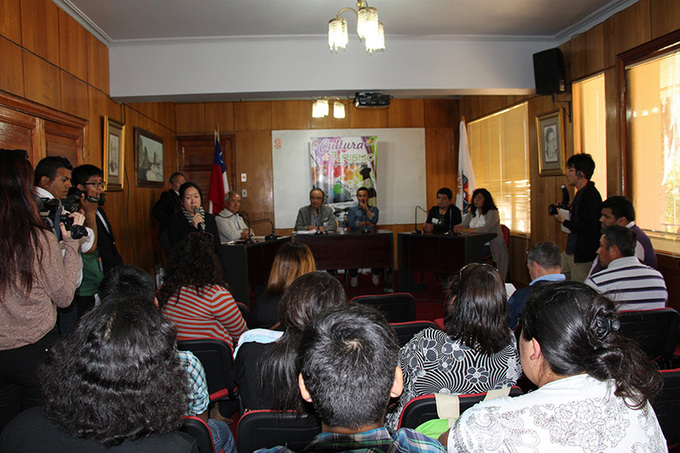
"Handing down the story" was the theme of the workshop in Constitución
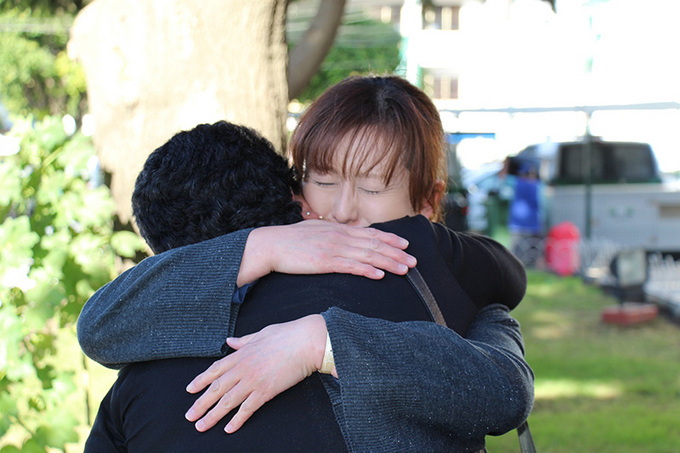
Sorrow has no borders

In Talcahuano, views were exchanged along the theme of "Tsunami evacuation measures"
Sharing fears of earthquakes and tsunami in Chile and Japan Kazuma Goto
This trip to Chile with the Musubi Juku gave me the chance to discuss the issue of how we can protect ourselves in the event of natural disasters. Japan and Chile are situated in earthquake-prone regions on opposite sides of the planet. December is the beginning of winter in Japan, but in Chile, the early summer sun shone brightly. In comparison to humid Japan, the climate in Chile is the exact opposite, very dry.
We held workshops in two cities, Constitución in the north and Talcahuano to the south, where we were welcomed at two high schools and a primary school. At each session, we shared our terrifying experiences of earthquakes and tsunami, and discussed how we can escape from such disasters. We were also able to visit a Chilean fishing village and observe the blessings of nature.
Chile is recovering from the disaster and the people are beginning a new life. Although there were still numerous scars of the earthquake and tsunami remaining along the shore, we could see that people were working energetically. I was struck by how different their ideas and policies were towards recovery, compared to Japan. It seemed that the recovery policy in Chile was not based on how to prevent a disaster, but on how to protect oneself in the event of a disaster.
Along the shore, we saw the beginnings of embankments built of stacked boulders and low seawalls to protect swimming areas, but these were not intended to hold back the tsunami. In another area where it looked as though houses had been swept away by the waves, we saw wooden houses being built on tall foundations of ferroconcrete. For those people who want to return to living on the waterside, the government subsidizes these types of houses, but it will not guarantee the safety of the structures in future disasters. Whereas, for those wishing to move to higher ground, the government is providing detached homes and plots of land, and people have begun to take up the offers.
We heard a number of calls concerning the government's evacuation warnings and earthquake prediction, but it seemed that there was the widely accepted understanding that people made their own decisions on how to escape.
That being said, we could see there was still great sorrow and suffering among the victims' families. Many people in Chile are Catholics and they tend to believe that disasters are God's punishment for wrongdoing. So they are reluctant to share their sorrows with those outside the immediate family and there is little spiritual relief for those unfortunate people. Since they tend not to share their suffering with others, the memories of the events are not passed down to future generations. This was proved by the fact that very few people remembered the earlier disaster of 1960.


Workshops took place at two high schools and a primary school to discuss about earthquake disasters
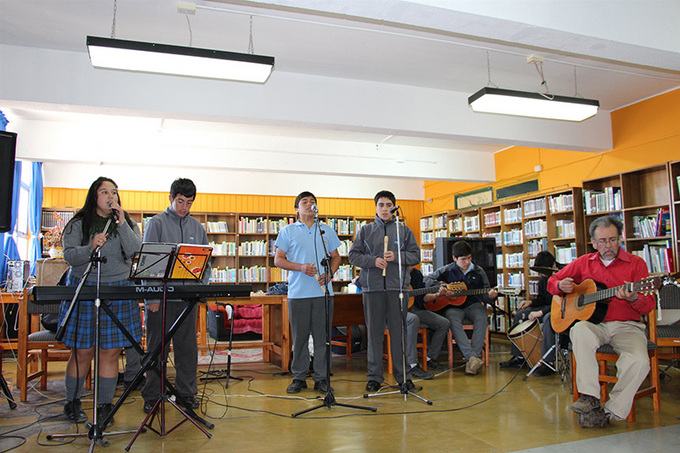
Members of a high school music club and their teacher entertained us with traditional Chilean music
With people joining hands around the world, information on disaster prevention can be shared Takuro Kimura
An innovative project that encouraged disaster witnesses in both countries to exchange valuable information
Huge earthquakes hit Chile in 1960 and 2010, and the resulting tsunami reached Japan, causing damage in many areas. Also, apart from those two earthquakes, Chile has been battered by numerous other tsunami and, therefore, can be regarded as a tsunami-prone country.
In the 30 years since the Middle Japan Sea Earthquake of 1983, Japan has been hit three times by large-scale tsunami. In 2011, the huge tsunami that followed the Great East Japan Earthquake demonstrated the difficulty of making coastal structures disaster proof. It became clear once again that the emphasis on tsunami countermeasures should be shifted to so-called "soft" measures. What's more, residents of the coastal areas devastated by that earthquake and ensuing tsunami have greatly changed their attitudes towards natural catastrophe, and in the area of "soft" strategies, they have achieved significant results.
In the aftermath of the 2011 earthquake, Japan received generous support from other countries around the world. As a means of offering gratitude for that help, Japan should make it its duty to share the knowledge and lessons derived from that tragedy to other tsunami-prone countries. The Musubi Juku workshop held in Chile proved to be a remarkable project because it succeeded in bringing together participants from both countries who had faced the disasters and it helped them to learn from those experiences and suggest plans for the future, something that had never happened before.
In Chile, information on the damage caused by the 1960 and 2010 tsunami were far from adequate. Not until this workshop was held did the overall outline of the two disasters become clear, and it turned out that Japan could also learn some lessons.
n view of the fact that Chile had already experienced a disastrous tsunami in 1960, just 50 years before the latest blow in 2010, the first theme to consider was how accounts of the recent experience should be passed on to the following generation. In Constitución, we decided to run the workshop along the theme of "handing down the story." And in Talcahuano, since both Chile and Japan are earthquake-prone countries, we exchanged views on the city's current enforcement of tsunami evacuation measures and problems that have surfaced so far.
If people take appropriate measures to evacuate, then the damage can be kept to a minimum. Lessons derived from analyzing the 2010 tsunami
According to the residents, the 2010 earthquake was bigger than the previous one in 1960. It also happened that some fairly old buildings managed to remain upright, pointing to the likelihood that the earthquake's intensity was the equivalent of 6 Lower to 6 Upper on the Japanese seismic scale. The tsunami reached the city of Constitución about 20 minutes after the tremor and the waves were about 10 to 15 meters high.
Of the 525 people who lost their lives as a result of the quake in Chile, around 120 were victims of the tsunami.
Putting aside the exceptional tragedies that struck Orrego and its neighboring island Cancún, where as many as 102 people died altogether, we learned that about 20 people lost their lives after failing to outrun the tsunami, accounting for 5 percent of the total fatalities.
In Talcahuano, the tsunami was reported to have arrived 90 minutes after the quake. The waves were six meters high, considerably bigger than in 1960 when they reached one meter in height. In the Las Salinas district of Talcahuano, the fishermen sensed the impending danger and shouted to all the residents to flee to a nearby hill. Not a single life was lost there.
Although there were slight differences according to location, we realize that while the 2010 tsunami reached the land in a comparatively short time and, moreover, struck in the middle of the night, the human toll was not as heavy as might have been feared. There were several reasons for this:
・Not that many people lived by the shore. (In 1960, the numbers were even fewer than now.)
・Those who did live near the sea were fishermen who would be aware of any changes in the ocean, such as the likelihood of a tsunami.
・Remembering the 1960 earthquake and tsunami, families discussed evacuation measures among themselves.
・Before 2010, the government held three evacuation drills, (but none, since).
・Some residents fled in their cars, but since it was in the middle of the night, there was very little traffic and very little confusion as a result.
From what we learned about the disasters in Chile, we realized that if people can flee in a well-judged way after an earthquake, the damage can be kept to a minimum.
One fisherman living in Las Salinas, Talcahuano, said that his home was submerged in two meters of water after the 2010 tsunami. Moreover, he has had to evacuate his home a total of four times, from 1960 to the tsunami caused by the Japanese quake in 2011. He also told that the water reached as high as the first floor ceiling of his house in 2010. New two-story houses are now being built up in his neighborhood, but he has no intention of moving elsewhere. He has repaired his home and means to stay there.
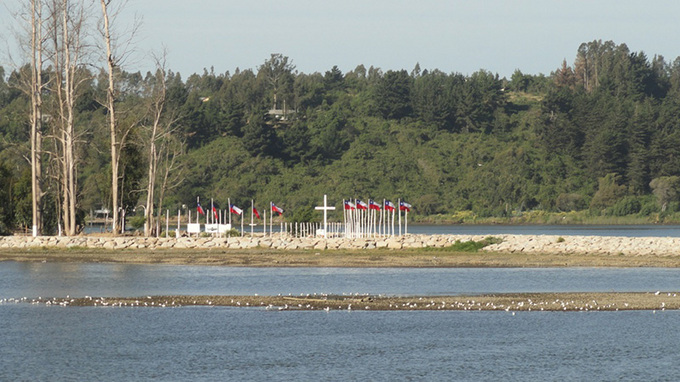
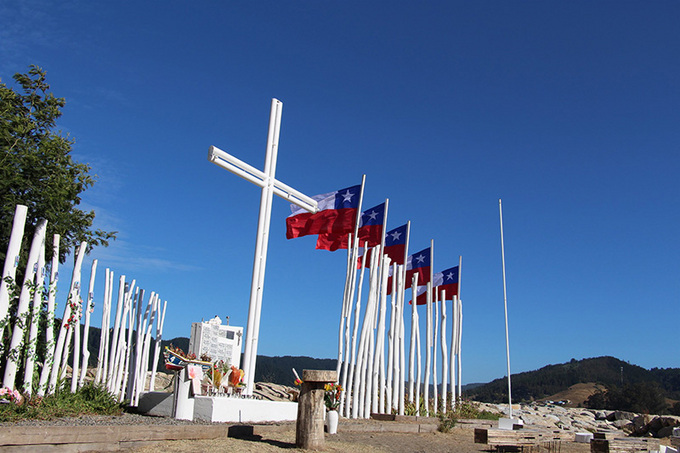
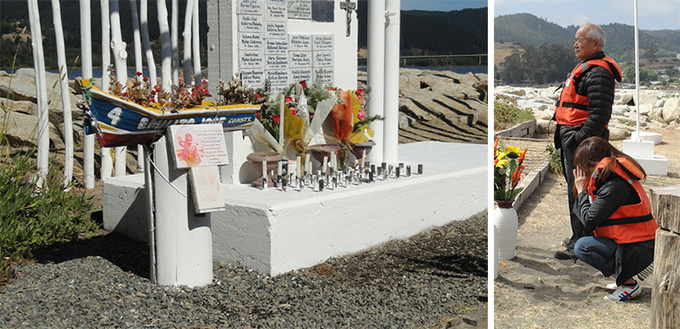
[The tragedy of Orrego Island]
Fifty people lost their lives on Orrego Island in Constitución. This was a normally uninhabited island, 20 hectares in size, situated in the mouth of the Maule River. A mere five minutes by boat from the city, it had been used for a long time as a camping site by local residents. On February 27, 2010, more than 60 people, both locals and visitors, were believed to have been on the island. When the earthquake struck, there were no boats docked at the island, and while authorities were aware of the danger of a tsunami, no official rescue teams arrived to deal with the ensuing disaster. Witnesses say, however, that small private boats did arrive to help with the evacuation. All in all, only 13 people survived.
Theme: handing down the story of the earthquake
(1) Remarkable efforts made by individuals
Some families, who lost their children on Orrego Island, were determined to take action to convey that the tragedy should not be forgotten and, by October 2010, they had erected a cross in their memory on the island. The families also petitioned the government to have camping forbidden on the island so that a similar tragedy would not be repeated. In response, the authorities purchased the island and it is now out of bounds for campers. It has been designated as a memorial park to mark the 2010 earthquake.
Some families have also kept copies of newspapers that covered the disaster so that the brothers and sisters of the victims will never forget the tragedy.
Instead of relying on the authorities, the families are making various efforts to preserve the memories of the earthquake and tsunami on a personal level. But there are limits to how long they can keep up these efforts to hand down the story, so we should now explore ways to work together with official or public organizations to continue the endeavor.
(2) Remnants of the disaster
Three years have passed since the Chile earthquake, but many visible scars of the tragedy remain.
The remains in Talcahuano harbor include a giant tugboat (the Poderoso) lying on its side and the burnt-out shell of the two-story customs office. In the Dichato district of Tomé City, the ruins of several houses still remain. There are plans to turn the customs office into a memorial museum, but discussions on whether to preserve these structural remnants have yet to be determined.
These relics of the disaster are an important means of passing down the story to future generations, so I believe that they should be preserved.
Discussions on preserving the structural remnants as essential reminders of the disaster need to be carried out
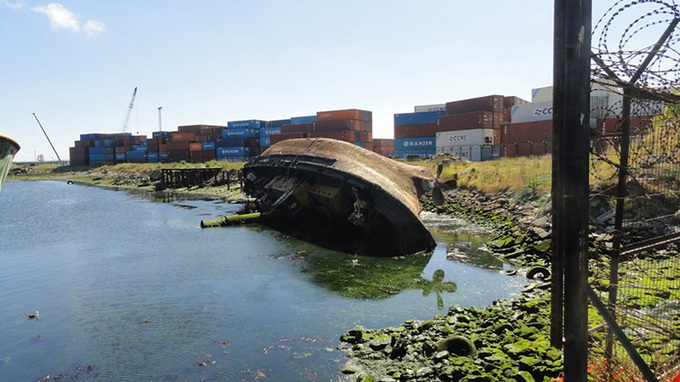
Capsized tugboat
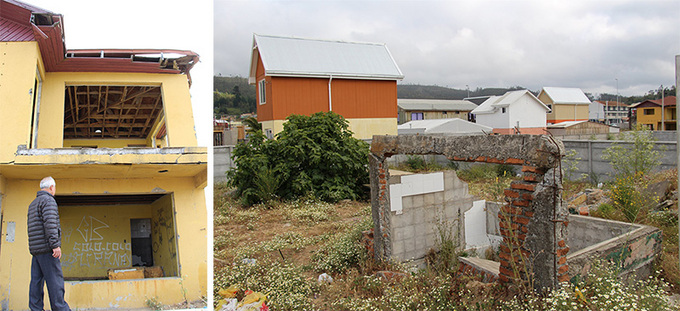
(Left) Ruined house, (Right) Structural ruins
Theme: tsunami evacuation measures
(1) Warning signs and security alarms
Even before the 2010 disaster, signboards were set up within the city to notify citizens of evacuation routes and evacuation zones. Boards that got swept away in the tsunami were duly replaced and their numbers increased.
In 2010, Chile was alerted by the Pacific Tsunami Warning Center in Hawaii, but was unable to make adequate use of the information. Having learned from this, the authorities have now set up solar-powered alarm systems.
But residents, especially fishermen who are familiar with the ocean from their daily work, are reluctant to trust the official announcements, and prefer to rely on their own instincts. To some extent, this kind of thinking has its merits. Relying on instruments to relay warnings has its pitfalls. There have been problems with faulty alarms or incorrect handling of the alarms, leading to the system not working properly. Hi-tech systems have their limits. So it is better to encourage residents, both in Chile and Japan, to get into the habit of relying on their own judgment, and to regard the electronic alarm systems as a backup for relaying warnings.
During the Musubi Juku workshop, we also discussed the issues of evacuating people who cannot fend for themselves and using cars to flee from tsunami, which proved to be grave problems in the 2011 disaster in Japan. We discovered that similar difficulties are present in Chile as well.
On the matter of evacuating by car, we learned that many of the streets of Constitución are narrow. What's more, parking along some of those streets is allowed. So if an earthquake struck during the daytime, the number of roads that could be used for evacuation would be severely limited. So it was important to realize the extent of the evacuation problem and to begin as soon as possible to develop everyday solutions to these problems.
(2) Holding evacuation drills
Evacuation drills have come into force since the 2010 disaster. Some people, however, are keen to put the tragedy behind them as soon as possible, so they don't want to take part in those practices. This situation has become a serious concern for the local residents' leaders.
(3) The need for disaster risk reduction education
In the event of the 2010 tsunami, a lack of understanding in the tsunami's mechanisms resulted in some residents failing to flee from their homes or, in some cases, they did flee, only to return shortly after to recover their belongings and then being caught up in the tsunami and losing their lives. During the Musubi Juku workshop, many of the Chilean members became aware of this problem and said they realized the need to have schools teach their pupils on ways of reducing the damage.
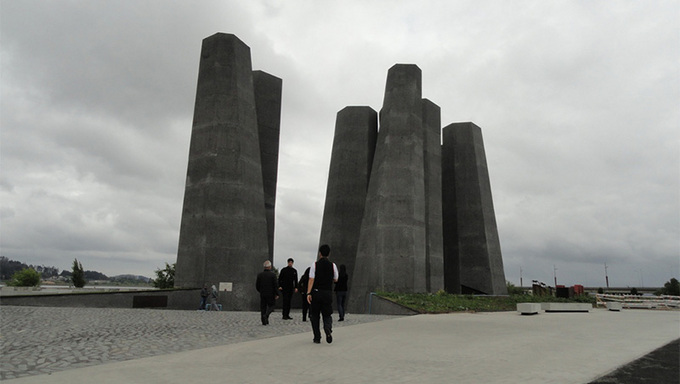
Monument to the disaster

(Left) Sign indicating evacuation zone, (Right) Restoration housing
Future mutual assistance
(1) Offering packaged "soft" solutions
As was mentioned earlier, the Chilean members of the workshops have great expectations towards Japan to supply them with "soft" measures for coping with tsunami. They can be summarized in these three points:
・Ways of handing down the tsunami experience: with remains of wrecked structures and storytellers' accounts of the disaster
・Education for disaster risk reduction: teaching children about the mechanisms of earthquakes and tsunami
・Evacuation measures: discussing earthquake measures with family, deciding on when to flee and how to take care of the elderly and people with disabilities
In Japan, various efforts have already been taken to familiarize people with these "soft" disaster prevention measures. Many points are still being worked out on a trial-and-error basis, but despite the differences in social systems and lifestyles, the overall package of measures should be valuable to the people of Chile, too.
The "soft" measures have not yet been fully systemized in Japan, but even if it is just fragments of information, we should convey them as soon as they become available.
(2) International cooperation in the preservation of disaster ruins
After the Great East Japan Earthquake of 2011, the question of what to do with the remaining ruins has arisen. Ruins are vital in passing down the memories of a disaster and in recent years, their preservation has helped in informing research visitors about the tragedies. In Banda Aceh, Indonesia, for example, two ships that were washed ashore after the 2004 earthquake have been preserved. In Japan, the government plans to subsidize efforts to preserve the ruins. And in Chile, there are a number of remaining structures and I think that their preservation should be considered as vital.
The time has come to recognize the fact that tsunami disasters are taking place on a global scale. International efforts should be made to preserve the remains, and individual nations should set up websites as part of their endeavor to reduce the risk of disaster.
(3) Holding workshops at the grass roots level to reduce disaster risks
People who live in overseas disaster regions are beginning activities to reduce disaster risks. Their efforts, however, tend to be series of trial-and-error, and many of their leaders are worried. The problems are many, including the question of how to develop successful ties with local residents and the authorities. An opportunity should be made as soon as possible for people around the world to come together and share information on the course and methods for dealing with this issue.
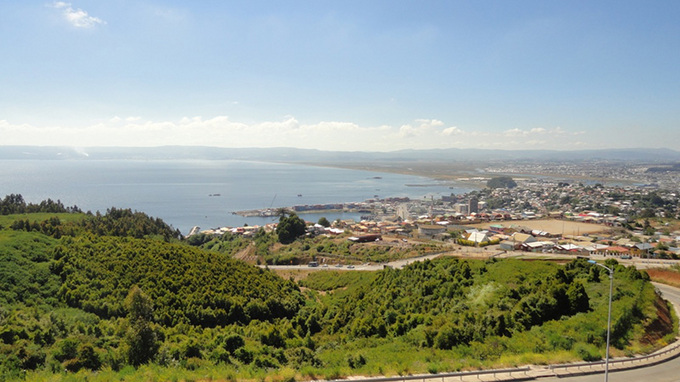
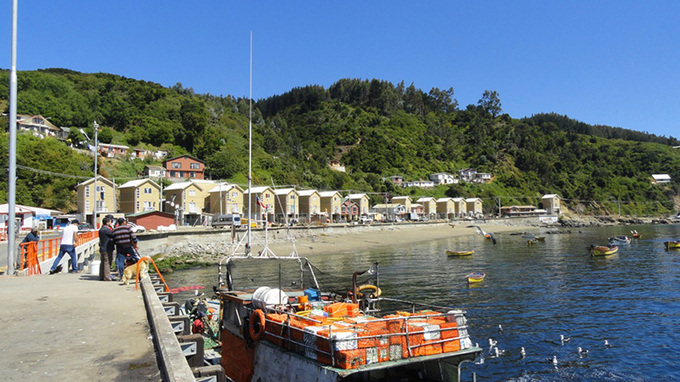
Fishing village in Chile
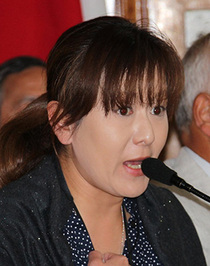 Maki Sato
Maki Sato
After the Great East Japan Earthquake, Sato began to visit various parts of Japan as a storyteller relating the tragedy of 2011. On the day of the disaster, she was in Ogatsu, Ishinomaki City, where she ran up a hill to escape from the tsunami.
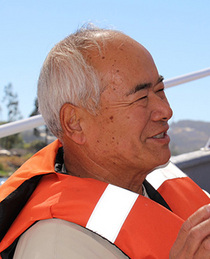 Kazuma Goto
Kazuma Goto
After the 2011 earthquake, Goto began working as a storyteller, informing visitors about his experience. On the fatal day, he took refuge in the hills in Tokura, Minamisanriku Town.
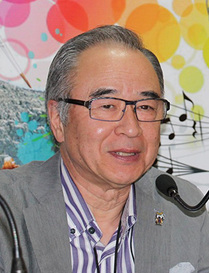 Takuro Kimura Director of GENSAI (GLOCAL EMPOWERMENT, SUPPORT and AID INSTITUTE) and Doctor of Engineering
Takuro Kimura Director of GENSAI (GLOCAL EMPOWERMENT, SUPPORT and AID INSTITUTE) and Doctor of Engineering
Kimura has devoted himself to disaster prevention measures since 1971. Based on his survey of earthquakes and volcanos, he has drawn up disaster prevention plans for many local authorities, and set up the basic scheme for Shizuoka Prefecture's disaster prevention center and plans for many other disaster-related facilities. After the eruption of Mt. Unzen in 1992, the Great Hanshin Earthquake of 1995, and the eruption of Mt. Usu in 2000, he took part in drawing up plans for the recovery of those areas. Recently, he has turned his attention to the problems faced by victims of natural disaster, such as coping in emergency shelters and rebuilding their lives. Ever since their beginning, Kimura has taken part in planning and moderating disaster-related workshops organized by the Kahoku Shimpo Publishing Company.
Back Issues
- 2022.11. 1 Inner Diversity<3> <…
- 2022.9. 5 Report on the India-…
- 2022.6.24 The 48th Japan Found…
- 2022.6. 7 Beyond Disasters - …
- 2021.3.10 Crossing Borders, En…
- 2020.7.17 A Millennium of Japa…
- 2020.3.23 A Historian Interpre…
- 2019.11.19 Dialogue Driven by S…
- 2019.10. 2 The mediators who bu…
- 2019.6.28 A Look Back at J…

